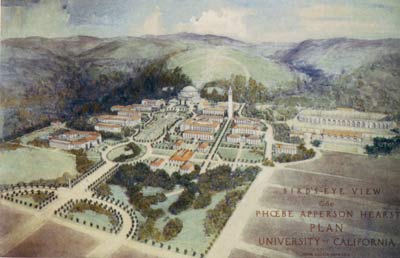Planning a ‘City of Learning’
Architect John Galen Howard’s renderings of campus buildings
![]()
| 12 March 2003
| |  John Galen Howard’s ambitious plan for the Berkeley campus, seen in the 1917 rendering above. |
Perhaps more than any other individual, architect John Galen Howard shaped the face of the Berkeley campus. In her new book, “John Galen Howard and the University of California: The Design of a Great Public University Campus” (UC Press; $44.95), architectural historian Sally Woodbridge rolls back the clock to the 1890s, when the Regents sought ways to improve the University.
Bernard Maybeck, then a mechanical-drawing instructor in the engineering department, proposed an architectural competition that would inspire a “grand vision” (in Woodbridge’s phrase) to transform the undistinguished campus. Maybe, it was felt, architectural renderings would encourage legislators and philanthropists to support the university.
When the international competition was announced, Phoebe Apperson Hearst, widow of U.S. Senator George Hearst, emerged as the major donor, offering to fund not only the competition but two buildings from the winning plan. Woodbridge writes that Maybeck was “largely responsible for the competition prospectus, which outlined an unparalleled — indeed, scarcely believable — opportunity for architects.” Said the prospectus:
“The purpose is to secure a plan to which all the buildings that may be needed by the University in its future growth shall conform. All the buildings that have been constructed up to the present time are to be ignored, and the grounds are to be treated as a blank space to be filled as a single beautiful and harmonious picture as a painter fills in his canvas.
“The site … comprises 245 acres of land, rising at first in a gentle and then in a bolder slope from a height of about 200 feet above the sea level to one of over 900....It is thought that the advantages of the site, whose bold slope will enable the entire mass of buildings to be taken in at a single coup d’oeil, will permit that production of an effect unique in the world, and that the architect who can seize the opportunity it offers will immortalize himself….
“Here there will be at least 28 buildings, all mutually related and, at the same time, entirely cut off from anything that could mar the effect of the picture. In fact, it is a city that is to be created — a City of Learning — in which there is to be no sordid or inharmonious feature.…There will doubtless be developments of science in the future that will impose new duties on the University, and require alterations in the detailed arrangement of its buildings, but it is believed to be possible to secure a comprehensive plan so in harmony with the universal principles of architectural art, that there will be no more necessity of remodelling its broad outlines a thousand years hence than there would be of remodelling the Parthenon, had it come down to us complete and uninjured.”
The winner of the competition, Émile Bénard of Paris, delivered a series of designs — but when he traveled to Berkeley, he managed to insult virtually everyone he met, and persuaded the Californians that he was not to be entrusted with the execution of any of his work. Enter John Galen Howard.
A New Englander who had attended MIT and the Ecole des Beaux-Arts in Paris, Howard spent a year in Los Angeles before entering the Berkeley architectural competition (in which he finished fourth). Because of his California connections, he was appointed to an advisory council to “oversee the implementation of Bénard’s designs.” President Benjamin Ide Wheeler subsequently appointed Howard as the supervising architect of the university in 1901.
Howard developed a style of architecture that was inspired by stately classical lines. Among the campus landmarks built during his tenure were the Hearst Memorial Mining Building (1902-07), the Hearst Greek Theatre (1903), California Hall (1905), Doe Library (1911-17), the Campanile (1914), Wheeler Hall (1917), Gilman Hall (1917), and Hilgard Hall (1918). This ensemble of buildings helped transform what had been a pedestrian institution into a true “City of Learning,” the UC Berkeley campus of today.
“John Galen Howard and the University of California” may be ordered online from UC Press, ucpress.edu/books/pages/9458.html. A multimedia slide show featuring additional illustrations and photos from the book is viewable at berkeley.edu/news/multimedia/2003/03/jgh/.

